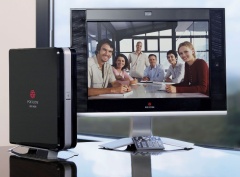Polycom launches new HD 720p video conferencing and presence solutions


The high definition version costs $10K and the standard definition version costs $8K. The Polycom HDX4000 features a DVI in from your PC and a DVI out that goes to the display. The port on the upper left is a customized DVI port that has integrated power which powers the high-definition 720p camera.
Pictured left is the newly released Polycom HDX8000 which is a lower cost version of the HDX9000 released earlier this year. It comes bundled with the motorized remote controllable HD "Eagle Eye" camera ($5K by itself), mix array, and remote shown in the photo. I asked Polycom why they didn't add an HDMI interface which carries audio and video data.
When Polycom showed a video coming from a Blu-Ray HD player over the HD Video conferencing link, it had to be inputted via analog component video because of HDCP copy protection restrictions because Polycom didn't implement HDCP. In fairness, I haven't seen any other vendor provide HDMI yet. The HDX8000 has a starting price of $11K and lets you have one camera input and one DVI output. For the $14K model, all the ports are enabled and you have twice the inputs and outputs.
Pictured above is the Polycom TPX tele-presence solution which costs $200K for the three screen 6 person version. It is essentially 3 HDX9000 series systems and 3 large Plasma displays plus the wood furniture and chairs. While the individual HDX9000 systems are compatible with other video conferencing solutions, there are no standards for merging the three screens and tele-presence solutions are all proprietary today. That means you can use this system to hold individual screen calls with other standard HD Conferencing systems from LifeSize and Sony and the middle camera will automatically zoom out to cover all 6 chairs. If you want all three screens and cameras to work, the other end needs to be the same system.
The system that was demonstrated to me at Polycom's office used ceiling microphones so that the desk could be wide open and not susceptible to noise generated from tapping the desk. However, I found this Mic arrangement less than ideal because the people on the other side had too much of a hall-way sound. Of course you don't have to use ceiling mics and you can use standard polycom desk mics but I was told that most people opted for the ceiling mics to keep the clean look. This could just be my personal preference but I prefer the sound of the desk mics which sound more natural to me.
Update 10/18/2007 - A note on bandwidth usage for HD video conferencing in general. 720P requires a minimum of 1 mbps but preferably 2 mbps. For the tripple screen system, you need tripple that. For the two-screen system where one serves as a powerpoint monitor, you still need double so I recommend using WebEX or LiveMeeting instead which hardly takes any bandwidth. Cisco's 1080p system requires 6+ mbps per screen because you're talking much higher resolutions.
Note: All images sourced from Polycom.